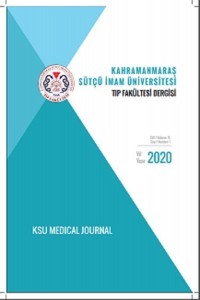Miadında Gebelerde Membran Stripping Yönteminin Gebelik Süresine Etkisi
doğum indüksiyonu, miad aşımı, servikal olgunlaştırma
Membrane Stripping Method’s Effect on Pregnancy Period for Term Pregnants
Cervical ripening, Prolonged pregnancy, Induction of labor,
___
- Nathanielsz PW, Giussani DA, Wu WX. Stimulation of the switch in myometrial activity from contractures to contractions in the pregnant sheep and nonhuman primate. Equine veterinary journal. Supplement. 1997:83–8.
- Alfirevic Z, Keeney E, Dowswell T, Welton N, Medley N, Dias S, et al. Doğum indüksiyonu için en iyi yöntem hangisidir? Sistematik bir inceleme, ağ meta analizi ve maliyet etkinliği analizi . Sağlık Teknolojisi Değerlendirmesi 2016;20 (65):1-584.
- ACOG. ACOG practice bulletin No. 97: Fetal lung maturity. Obste and Gyn. 2008;112: 717–26.
- Martin J, Hamilton B, Sutton P, Al E. Births: final data for 2006: National vital statistics reports. Hayattsville, MD Natl Cent Heal Stat. 2009;57(7):1–120.
- Bishop EH. Pelvic scoring for elective induction. Obstet Gynecol. 1964;24(2):266–8.
- Arulkumaran S, Gibb DMF, TambyRaja RL, Heng SH, Ratnam SS. Failed Induction of Labour. Aust New Zeal J Obstet Gynaecol. 1985;25(3):190–3.
- Xenakis EMJ, Piper JM, Conway DL, Langer O. Induction of labor in the nineties: Conquering the unfavorable cervix. Obstet Gynecol. 1997;90(2):235–9.
- McCarthy FP, Kenny LC. Induction of labour. Obstetrics, Gynaecology and Reproductive Medicine. 2014:24:9–15.
- Mozurkewich EL, Chilimigras JL, Berman DR, Perni UC, Romero VC, King VJ, et al. Methods of induction of labour: A systematic review. BMC Pregnancy Childbirth. 2011;11.
- de Vaan MD, ten Eikelder ML, Jozwiak M, Palmer KR, Davies-Tuck M, Bloemenkamp KW, et al. Mechanical methods for induction of labour. Vol. 2019, Cochrane Database of Systematic Reviews. 2019.
- Boyon C, Monsarrat N, Clouqueur E, Deruelle P. Maturation cervicale: Y a-t-il un avantage à utiliser un double ballonnet pour le déclenchement du travail ? Gynecol Obstet Fertil. 2014;42(10):674–80.
- Hill MJ, McWilliams GD, Garcia-Sur D, Chen B, Munroe M, Hoeldtke NJ. The effect of membrane sweeping on prelabor rupture of membranes: A randomized controlled trial. Obstet Gynecol. 2008;111(6):1313–9.
- McColgin SW, Bennett WA, Roach H, Cowan BD, Martin JN, Morrison JC. Parturitional factors associated with membrane stripping. Am J Obstet Gynecol. 1993;169(1):71–7.
- Mitchell MD, Flint AP, Bibby J, Brunt J, Arnold JM, Anderson ABM, et al. Rapid increases in plasma prostaglandin concentrations after vaginal examination and amniotomy. Obstet Gynecol Surv. 1978;33(6):385–6.
- Mitchell MD, Flint APF, Bibby J, Brunt J, Arnold JM, Anderson ABM, et al. Rapid increases in plasma prostaglandin concentrations after vaginal examination and amniotomy. Br Med J. 1977;2(6096):1183–5. Berghella V, Rogers RA, Lescale K. Stripping of membranes as a safe method to reduce prolonged pregnancies. Obstet Gynecol. 1996;87(6):927–31.
- Allott HA, Palmer CR. Sweeping the membranes: a valid procedure in stimulating the onset of labour? BJOG An Int J Obstet Gynaecol. 1993;100(10):898–903.
- National Institute for Health and Care Excellence. Inducing labour. Clinical guideline [CG70]. Available from: https://www.nice.org.uk/guidance/cg70/chapter/4‐research‐recommendations (accessed 4th April 2017]. 2008.
- Boulvain M, Irion O, Marcoux S, Fraser W. Sweeping of the membranes to prevent post-term pregnancy and to induce labour: A systematic review. BJOG An Int J Obstet Gynaecol. 1999;106(5):481–5.
- Finucane EM, Murphy DJ, Biesty LM, Gyte GML, Cotter AM, Ryan EM, et al. Membrane sweeping for induction of labour. Vol. 2020, Cochrane Database of Systematic Reviews.2020.
- Verani JR, McGee L, Schrag SJ, Division of Bacterial Diseases, National Center for Immunization and Respiratory Diseases C for DC and P (CDC). Prevention of perinatal group B streptococcal disease--revised guidelines from CDC, 2010. MMWR Recomm reports Morb Mortal Wkly report Recomm reports [Internet].
- 2010;59(RR-10):1–36. Available from: http://www.ncbi.nlm.nih.gov/pubmed/21088663 22.
- Tannirandorn Y, Jumrustanasan T. A comparative study of membrane stripping and nonstripping for induction of labor in uncomplicated term pregnancy. J Med Assoc Thail. 1999;82(3):228–32.
- Saichandran S, Arun A, Samal S, Palai P. Efficacy and safety of serial membrane sweeping to prevent post term pregnancy: a randomised study. Int J of Repro, Contra, Obstet and Gynecol 2015;4(6):1882‐6.
- Dare FO, Oboro VO. The role of membrane stripping in prevention of post-term pregnancy: A randomised clinical trial in Ile-Ife, Nigeria. J Obstet Gynaecol (Lahore). 2002;22(3):283–6.
- Wong SF, Hui SK, Choi H, Ho LC. Does sweeping of membranes beyond 40 weeks reduce the need for formal induction of labour? BJOG An Int J Obstet Gynaecol. 2002;109(6):632–6.
- Ugwu EO, Obi SN, Iferikigwe ES, Dim CC, Ezugwu FO. Membrane stripping to prevent post-term pregnancy in Enugu, Nigeria: a randomized controlled trial. Arch Gynecol Obstet. 2014;289(1):29-34. doi: 10.1007/s00404-013-2918-5. Epub 2013 Jun 14. PMID: 23764933.
- ISSN: 1303-6610
- Yayın Aralığı: Yılda 3 Sayı
- Başlangıç: 2004
- Yayıncı: Kahramanmaraş Sütçü İmam Üniversitesi
Miadında Gebelerde Membran Stripping Yönteminin Gebelik Süresine Etkisi
Fatih ADANACIOĞLU, Kadir GÜZİN
İrem AKIN ŞEN, Şenol ARSLAN, Cem ŞEN
Parkinson Hastalarında Nöropsikiyatrik Semptomlar
Tuğba KAYA, Buket TUĞAN YILDIZ
İnvajinasyonda Tedavi Yaklaşımı: Takip mi, Cerrahi mi?
Ömer KATI, Şükrü GÜNGÖR, Yaşar KANDUR, Ahmet Gökhan GÜLER
Sarkopeni’ye Genel Bakış ve İlişkili Faktörler
Tuba Tülay KOCA, Buket TUĞAN YILDIZ
Özge ÖZDEMİR, Can ACIPAYAM, Murat ARAL, Sedef TERZİOĞLU ÖZTÜRK
Tıp Fakültesi Anatomi Anabilim Dalı Yüksek Lisans Tez Konularının Değerlendirilmesi
Mehmet DEMİR, Sibel ATEŞOĞLU KARABAŞ, Fatma Beyzanur SUBAŞI, Atila YOLDAŞ
Alzheimer Hastalığını Hafif Bilişsel Bozukluktan Ayırmak İçin Basit Bir MRI-Tabanlı Görsel Kılavuz
HIV ile Enfekte Bireylerde Sifilis Koenfeksiyonu
Ahmet ŞAHİN, Selda ASLAN, Esin DOĞANTEKİN, Akif DOĞANTEKİN
İdiopatik Membranöz Nefropatide Tedavi Öncesi Serum Kompleman 3 Seviyesi ve Rituksimab Yanıtı
Engin ONAN, Dilek TORUN, Rüya ÖZELSANCAK, Hasan MİCOZKADIOĞLU
